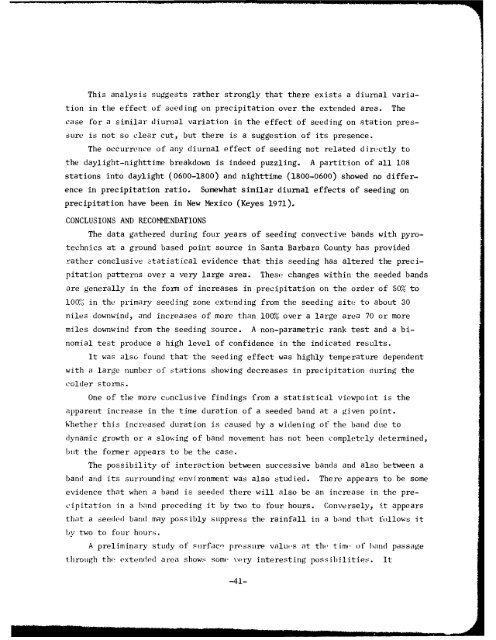pages - The Black Vault
pages - The Black Vault
pages - The Black Vault
- No tags were found...
Create successful ePaper yourself
Turn your PDF publications into a flip-book with our unique Google optimized e-Paper software.
This analysis suggests rather strongly that there exists a diurnal variationin the effect of seeding on precipitation over the extended area. <strong>The</strong>case for a similar diurnal variation in the effect of seeding on station pressureis not so clear cut, but there is a suggestion of its presence.<strong>The</strong> occurrence of any diurnal effect of seeding not related directly tothe daylight-nighttime breakdown is indeed puzzling. A partition of all 108stations into daylight (0600-1800) and nighttime (1800-0600) showed no differencein precipitation ratio. Somewhat similar diurnal effects of seeding onprecipitation have been in New Mexico (Keyes 1971).CONCLUSIONS AND RECOMMENDATIONS<strong>The</strong> data gathered during four years of seeding convective bands with pyrotechnicsat a ground based point source in Santa Barbara County has providedrather conclusive statistical evidence that this seeding has altered the precipitationpatterns over a very large area. <strong>The</strong>se changes within the seeded bandsare generally in the form of increases in precipitation on the order of 50%, to100%, in the primary seeding zone extending from the seeding site to about 30miles downwind, and increases of more than 100% over a large area 70 or moremiles downwind from the seeding source. A non-parametric rank test and a binomialtest produce a high level of confidence in the indicated results.It was also found that the seeding effect was highly temperature dependentwith a large number of stations showing decreases in precipitation ouring thecolder storms.One of the more conclusive findings from a statistical viewpoint is theapparent increase in the time duration of a seeded band at a given point.Whether this increased duration is caused by a widening of the band due todynamic growth or a slowing of band movement has not been completely determined,but the former appears to be the case.<strong>The</strong> possibility of interaction between successive bands and also between aband and its surrounding environment was also studied. <strong>The</strong>re appears to be someevidence that when a band is seeded there will also be an increase in the precipitationin a band preceding it by two to four hours. Conversely, it appearsthat a seeded band may possibly suppress the rainfall in a band that follows itby two to four hours.A preliminary study of surfacq prossure valu,,s at the time of band passagethrough the extended area shows somo very interesting possibilities. It-41-





![Combat Support in Korea [270 Pages] - The Black Vault](https://img.yumpu.com/49796461/1/190x71/combat-support-in-korea-270-pages-the-black-vault.jpg?quality=85)










